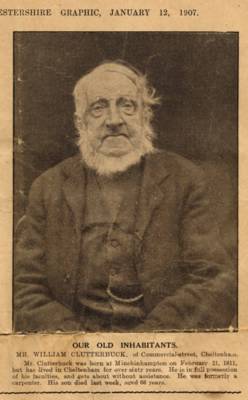Written by Edna Clutterbuck, nee Sloan
James Clutterbuck was born October 5, 1873 in Grantham Licolnshire, England. As a
Barr Colonist he came out from England in April 1903 on the
S.S.Manitoba. While on the ship they picked their homesteads. Jim in England was a skilled tradesman in wood and stone carving, a draftsman and a modeller. He was advised by his London doctor to go to a drier climate as he had a cough caused by the stone dust on his lungs from working on old Abbeys in England.
When they picked their homestead, this location later became part of the Durness district. At that time the railroad came as far as Saskatoon and now Clutterbuck joined forces with three other fellows. They bought four oxen, a wagon, ploughs and other supplies before setting out for their homesteads in mid April. The trip over the bald prairie, was really tough going, over sloughs and fording the Battle River. However the four oxen could handle it better than many horse outfits.
They pitched their tents one mile north of the present Lloydminster site. Within a few days their group set out with a guide to find their various homesteads. Clutterbucks’ homestead proved to be nine miles northwest of the meridian. They lived in tents until Jim built a log house with a sod roof. This was to be the shelter for the group for the first winter. In the summer of 1903, Jim and his neighbour Cowell, turned their first furrow.
The winter of 1904, Jim went to Winnipeg where he cut stone in Trindall Quarry for the building of the Union Station. When he returned to his homestead he and the other colonists, together with the early settlers, began to form communities. The Barr Colonists triggered off an influx of settlers in 1905. At this time the railroad arrived in Lloydminster, making it easier for supplies to come in. In 1908, a school was built, calling it Durness under the leadership of John Campbell. The name came from Durness, Scotland, where the Campbells had lived.
In the spring of 1909, Jim Clutterbuck received a message delivered by horseback from the Superintendent of Buildings for the province of Alberta. The Parliament Buildings were being built and they had written to England seeking a carver, a modeller and a draftsman. They were informed that a man by the name of James Clutterbuck was one of their best apprentices with all those qualifications and he had immigrated to Canada. They had traced him through Immigration. James carved the Provincial Coat of Arms over both entrances of the old Court House. In 1910, he started on the Parliament Buildings. He sketched many of the ornamental caps on the pillars and did all the carvings over the doorways.
In 1910 James married Isabel Campbell, a neighbour girl. The winter of that year he cut wreaths out of a sandstone quarry in Calgary. These were fussed on to the outside walls of the Parliament Building. Being of a soft sandstone, they most of them wore away over the years. Just a few remain on the west wall. James leased his homestead to Cowell allowing him to remain in Edmonton to complete the finishing touches to the elaborate building. One of his last jobs there was the British Coat of Arms which still stands over the House Speakers head in the Legislature. Then he returned to his homestead to begin farming. James and Isabell had two children, Mary born on the farm in 1913 and Thomas born in the Lloydminster Hospital in 1914.
Mary married Kenneth Bain of the Golden Valley District in 1936 and they had four children, Isabell, Betty John and Donalda. In 1947 their father, Ken died. Thomas married Edna Sloan in 1938 in Lloydminster. Edna and Tom carried on farming while raising three children. Glen married and is living in Kamloops B. C., Linda is married and living in Penticton, B. C., and Bob is married and living in Calgary. Tom’s father, James, and his neighbour, Stanley Inge, who lived three miles away died on the same day, July 1st, 1954.
Tom served as School Trustee for twelve years and five as Divisional Trustee on the Vermilion School Division. Durness school was closed and Tom and Edna owned and operated the Durness school bus from 1956 to 1972. In 1963, Tom took a job as operator on husky Automation pipeline, still operating the farm and with Edna driving the bus. Tom resigned from the pipeline, sold the farm and moved into Lloydminster. He started a city school bus service while still driving the Durness bus. In 1974, Tom sold the bus service and worked for the Hardware manager in Fisher’s Store. Edna worked at Sandy’s News until they moved to Penticton, B.C. in 1978. Tom’s sister, Mary died in 1979. Tom was seventy eight when he died in 1992.
Tom’s widow, Edna wrote this story in the year 2000. She included two pictures of James Clutterbuck with his team of oxen on the homestead, which can be seen in the story as it was originally published on
Lloydminster.Net.
Please share your Clutterbuck stories.



